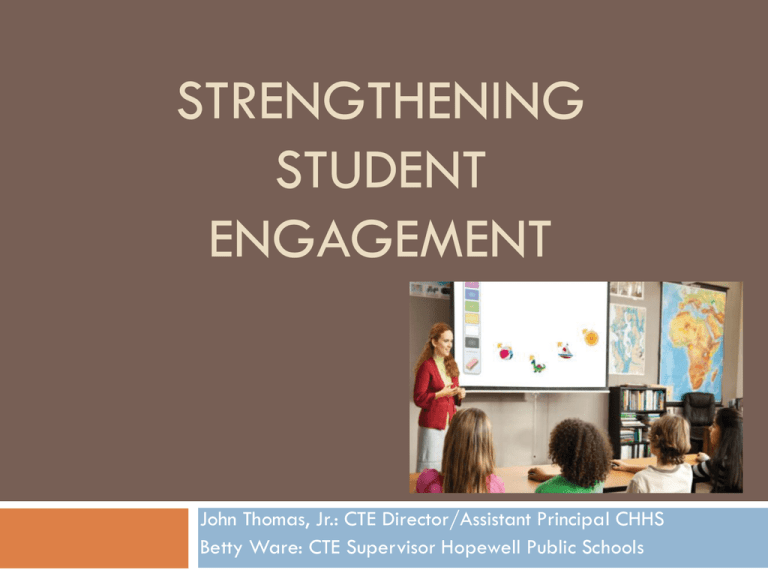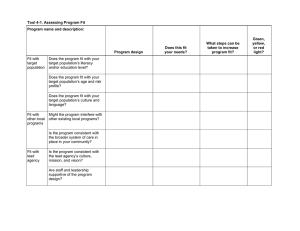STRENGTHENING STUDENT ENGAGEMENT
advertisement

STRENGTHENING STUDENT ENGAGEMENT John Thomas, Jr.: CTE Director/Assistant Principal CHHS Betty Ware: CTE Supervisor Hopewell Public Schools What is Your Idea of Student Engagement vs. The Students Engagement-Based Learning and Teaching Approach - EBLT Three domains of student engagement: Cognitive consists Domain of beliefs and values Emotional Consists Domain of motivation and feelings Behavioral Consists Domain of habits and skills With this approach, teachers and parents work together across all three domains to cultivate and support student engagement at the highest level. The Key Elements of How to Implement EBLT Cultivate one-on-one relationships Learn new skills and habits Incorporate systematic strategies Take responsibility for student engagement practice Promote a school-wide culture and engagement Professional development as an important part of increased student engagement Pre-Classroom Conditions Factors that must be in place before classroom instruction begins: Learning relationships Creating the Ideal classroom environment Rewards and incentives Guiding principles Fundamental skills Habits How Can Teachers Create an Environment where Rigorous and Relevant Learning Takes Place Create a design for rigorous and relevant learning Personalize learning Use active learning strategies Focus on reading Learning Relationships Taxonomy Strong positive relationships are critical to the education process. Think about that one teacher you will never forget and how they impacted your learning experience. Classroom Management vs. Learning-Based Relationships The teacher’s responsibility for teaching and learning in the classroom often is divided into instruction and classroom management. How to Improve Relationships Relationships in school always can be improved. Schools can engage in specific practices to improve the quality of those relationships that influence student learning and operation of a school. Supportive behaviors are ways in which teachers act and interact with students to support learning and good relationships. Supportive Initiatives are social initiatives that contribute to learning and good relationships. Supportive structure constitute major organizational changes that contribute to learning and good relationships. Adult & Peer Behaviors Greatly Influence Learning Relationships Showing respect “Being there” for students and frequent contact Active listening One-on-one communication Encouraging students to express opinions Avoiding “put-downs” Writing encouraging notes Students praising peers Celebrating accomplishments Supportive Initiatives Influence Relationships Social activities to start the year Team building Mentoring Rewards, recognition, incentives Student advocacy Advisory programs Peer mediation Students as teachers Character education What Can the School Do? Schools can also implement major changes to their structures that can make it easier to develop positive learning relationships, such as: Small learning communities Alternative scheduling Team teaching Team continuity School-base enterprises Professional learning communities References


